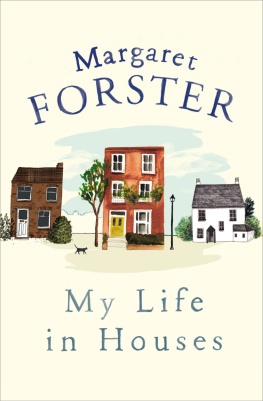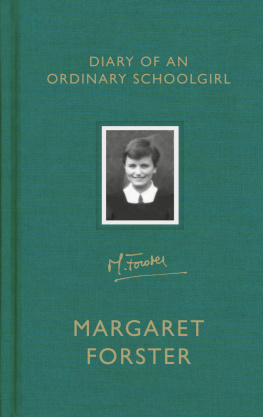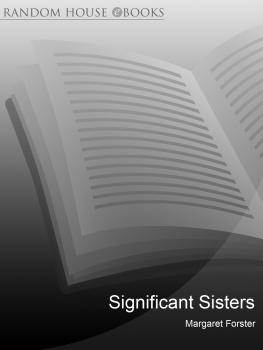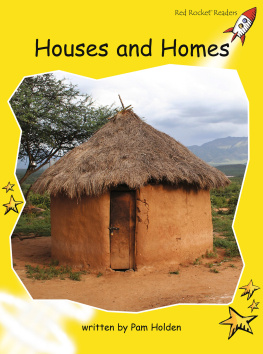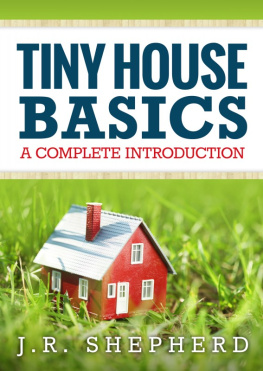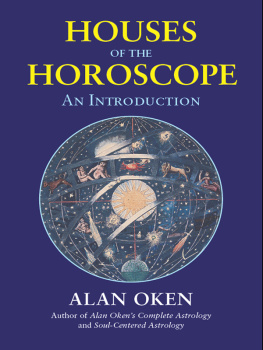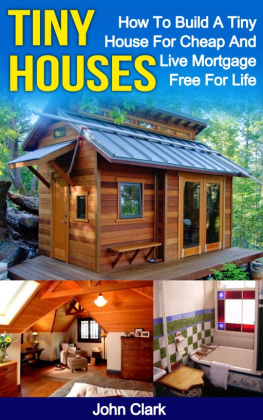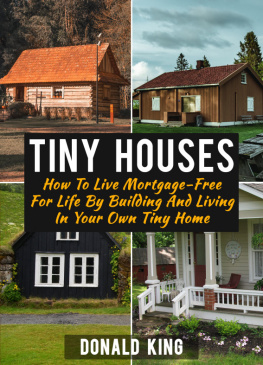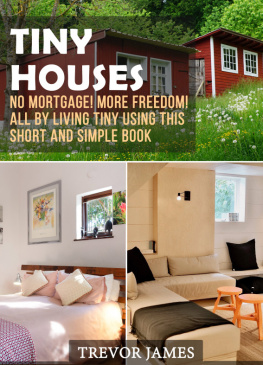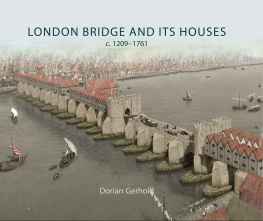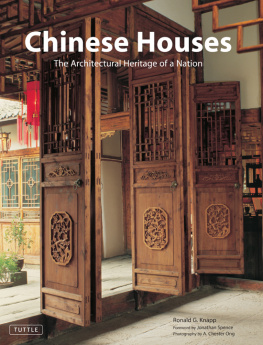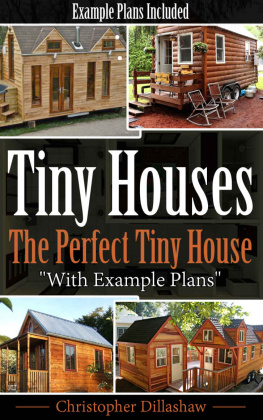Contents
About the Book
I was born on May 25, 1938, in thefront bedroom of a house in Orton Road,on the outer edges of Raffles, a councilestate. I was a lucky girl.
So begins Margaret Forsters journey throughthe houses shes lived in, from that sparklingnew council house, built as part of a utopianvision by Carlisle City Council, to herbeloved London house of today, via Oxford,Hampstead, the Lake District and a spell inthe Mediterranean.
This is not a book aboutbricks and mortar, or abouthow a house becomes ahome with the right scatterof cushions.
This is a book about whathouses are to us, the effectthey have on the way welive our lives. It is also awonderful backwards glanceat the changing nature of our accommodation:from blacking grates and outside privies; tocities dominated by bedsits and lodgings; tohouses today being converted back into singledwellings, all open-plan spaces and bringingthe outside in.
Quietly moving, it is also a very personalinquiry into the meaning of home.
About the Author
Born in Carlisle, Margaret Forster is theauthor of many successful and acclaimedworks of fiction and non-fiction. Her novelsinclude Have the Men Had Enough?, LadysMaid, Diary of an Ordinary Woman, Is ThereAnything You Want?, Keeping the World Away,Over and, most recently, The UnknownBridesmaid. She has also written bestsellingmemoirs, Hidden Lives and Precious Lives,and biographies including Elizabeth BarrettBrowning and Daphne du Maurier. She ismarried to writer and journalist HunterDavies and lives in London and theLake District.
ALSO BY MARGARET FORSTER
FICTION
Dames Delight
Georgy Girl
The Bogeyman
The Travels of Maudie Tipstaff
The Park
Miss Owen-Owen is At Home
Fenella Phizackerley
Mr Bones Retreat
The Seduction of Mrs Pendlebury
Mother Can You Hear Me?
The Bride of Lowther Fell
Marital Rites
Private Papers
Have the Men Had Enough?
Ladys Maid
The Battle for Christabel
Mothers Boys
Shadow Baby
The Memory Box
Diary of an Ordinary Woman
Is There Anything You Want?
Keeping the World Away
Over
Isa & May
The Unknown Bridesmaid
NON-FICTION
The Rash Adventurer: The Rise and Fall of Charles Edward Stuart
William Makepeace Thackeray: Memoirs of a Victorian Gentleman
Significant Sisters: The Grassroots of Active Feminism 18391939
Elizabeth Barrett Browning
Daphne du Maurier
Hidden Lives
Rich Desserts & Captains Thin: A Family & Their Times 18311931
Precious Lives
Good Wives?: Mary, Fenny, Jenny and Me 18452001
POETRY
Selected Poems of Elizabeth Barrett Browning (Editor)
I WAS BORN on 25th May 1938, in the front bedroom of a house in Orton Road, a house on the outer edge of Raffles, a council estate.
I was a lucky girl. Carlisle City Council was quite flushed with pride over this estate, consisting as it did of two thousand houses. It had responded with enthusiasm to the Kings speech of April 1919, in which he had said the only adequate solution to so many of the population living in inadequate housing was to build more houses specifically for the poor. There were lots of the poor in Carlisle, many of them crammed into slum dwellings in Caldewgate, where most of the factories were situated. In 1920, a report on the Sanitary Condition of the City of Carlisle had condemned the majority of dwellings in Caldewgate as unfit for habitation yet they were all heavily inhabited. The report spoke of a bad arrangement of lanes and courts, pointing out how few houses had an internal water supply, and that none had their own lavatory. The yards in common use meant infectious diseases spread rapidly. It was this dire situation that the new council estate, to the north-west of Caldewgate, was built to redress: to get these poor out into the green fields of Raffles.
My parents, though, couldnt be categorised as belonging to the poor, but the council was enlightened enough to realise that for the future health of the new estate it might be a good idea to have a few young married couples, just starting off, mixed in with families removed from the slums. My father, a fitter working in Hudson Scotts factory, at least qualified as a manual worker (ninety-one per cent of those allocated houses were manual workers). My mother, who up to marrying in 1931 was a secretary in the Health Department, was strictly speaking a class above him, but, as all women did, she had to give up her job once they married. Both of them were born in Carlisle, and both lived in houses owned by their parents, small terraced houses in working-class areas but nevertheless owned, not rented. They could well have had to start off married life living with one or other of their parents so they were pleased to be able to rent a new house of their very own, at six shillings a week, just under a quarter of my fathers weekly wage.
They had both been familiar with the fields of Raffles before the estate was built. The ninety-eight acres purchased by the council stretched either side of the road leading west to Wigton. Not much had ever grown there, except poor-quality grass, because the soil was thick with clay and drainage was difficult. The new estate wasnt spoiling a beautiful area of countryside. In any case, the idea was that Raffles should be a housing estate of the garden city variety with great care to be given to its layout. There were to be lots of green spaces left, and only twelve houses built on any one acre, with a pleasing mixture of terraces and semi-detached dwellings. There was to be a church, shops and a park. It would be a model of its kind.
The estate had just been completed when my parents moved into Orton Road in 1931. The house was on a corner, facing into Orton Road which skirted the western side of the estate. It was semi-detached, with a garden on three sides. Inside, there was a living room, a tiny back kitchen, two bedrooms and a bathroom where there was indeed a bath but no sink or lavatory. The lavatory was part of the fabric of the house but could only be reached by going out of the backdoor and into the adjoining outhouse. There had been huge arguments about this at council meetings, mainly over the expense of putting lavatories in bathrooms. Clearly that was ruled out. But the less-expensive possibility of simply knocking through into the outside lavatory from the kitchen was not gone into. Good heavens, these people should be grateful to have their own lavatory even if they often had to get soaked going out to it. And they were.
My parents were ideal tenants. They looked after their rented house perfectly. This maintenance was not easy. The house was heated by an open fire set in the black iron range which filled one wall of the living room. The black leading of this range was an unpleasant job, one that hadnt changed from Victorian times, and the laying and cleaning out of the coal fire was a wearying task. Because of this coal fire, there was always a lot of dust so keeping things clean was a constant challenge. Luckily, perhaps, there was not much furniture to keep clean: a settee, an armchair, a table, four wooden chairs and a sideboard, most bought in auctions. Quite enough, though, to make the fourteen by twelve foot room look crowded. In the back kitchen there was a gas cooker and a sink, with a wooden board to the left of the sink which served as a worktop. Upstairs, in the room where I was to be born, there was a double bed, a wardrobe, a dressing table and a chest of drawers. Later, when there were three children, an alcove was turned into a Scottish-style bed-in-the-wall, or in other words a mattress was put on top of a board laid across the alcove, with a curtain rigged up in front of it to give an illusion of privacy. There was another small bedroom at the back, in which, for a while, my maternal grandmother stayed, until she died in 1936.
Next page
